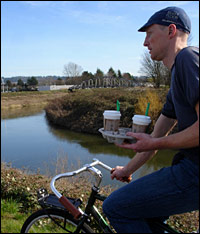Dear Umbra,
Now that there are promises that the snow will melt someday, I’m dreaming about biking again — to work, to the farmers’ market, to church, etc. However, my sweet husband loves to make me coffee and send it with me when I leave the house. I have wonderful reusable coffee cups for the car, but how do I transport coffee on a bicycle without ruining it or me? Any bright ideas?
Caffeine Appreciator
Duluth, Minn.
Dearest CA,
“Thermos thermos thermos, you keep things hot all day, thermos thermos thermos, you’re leak proof and lightweigh … t.” My bright idea is a thermos. I have had this bright idea before, but as far as I am concerned a thermos never loses its luster as an idea. Perhaps it will seem newer if I say, “The Dewar flask is for you.”
The Scotsman scientist James Dewar (born in Kincardine-on-Forth, Scottish enough for anyone) invented the vacuum flask in 1892 to help him with his physics experiments. Apparently he needed to keep liquid gases cold, and keep them cold he did. (He has no apparent connection to the Dewar’s Scotch people, though they no doubt appreciated his invention.) Today, Umbra’s Science-o-Matic will summarily brief us all on how the thermos/vacuum flask/Dewar flask works.
Very, very briefly, the thermos stymies the processes of heat exchange. As you know, objects want to share heat with one another through contagious molecular movement — they’re generous that way. Your warm house air wants to spread the warmth to the outside, your coffee gives its heat to the surrounding air and itself becomes tepid — air and objects of different temperatures will exchange heat until they reach a happy medium of equality. Your coffee, just like everything containing molecules, accomplishes heat exchange in three ways. One way is infrared radiation, a form of light given off by hot items, which we feel as heat rather than see as light. A thermos attempts to minimize the transfer of radiative heat by lining the flask with shiny material, such as steel or silvered glass. The radiative heat is mostly reflected back into the coffee, and heat loss is slowed.
A vacuum flask is also designed to thwart conduction, the heat transfer that happens when molecules are touching and the hot, jumpy molecules transfer their jumpiness to cold, sluggish molecules, making the cold molecules warm. A vacuum flask is actually two flasks, one inside the other. In between the two flasks is a vacuum: no molecules at all. The coffee may be able to heat the inner flask, but there are no molecules in the vacuum to be heated and carry that heat outside the bottle, so the heat is retained in the inner flask.
The vacuum also limits the third heat transfer, convection. Hot molecules expand, become lighter, and rise to the top (of the coffee), where they usually then transfer their heat to the colder air molecules. Again, the tricky absence of molecules in a vacuum impedes this process.
I hope you can see that as far as coffee staying hot on your ride is concerned, a vacuum flask is the answer. Obviously this must be a small (light) flask with a very tight, secure closure, which would fit inside your backpack, carrier bag, or pannier. I inadvertently bought exactly such an item a couple years back, thinking it was a travel mug; I also have a smallish thermos. Both of these would be — in fact, are proven to be — perfect for transporting hot beverages by bicycle. I got my “thermal wide-mouth stainless steel bottle” at Reusable Bags, but this is in no way an exclusive endorsement of that website or that particular bottle. I tell you only to give you a visual image and an idea of how to start looking for the perfect Dewar flask.
If anyone is at a loss as to how to best transport items by bicycle, and the above suggestions are Greek to you, I encourage letters on the topic. I always welcome bicycling letters, as they help with proselytizing.
By the way, Thermos is itself a brand name but also an accepted general term for vacuum flasks. I just would like to close with an apt slogan from Thermos itself: “Thermos: a brand that exists to fulfill human needs.” The human needs to bike, and the human needs hot coffee — the thermos is here.
Vacuumly,
Umbra


